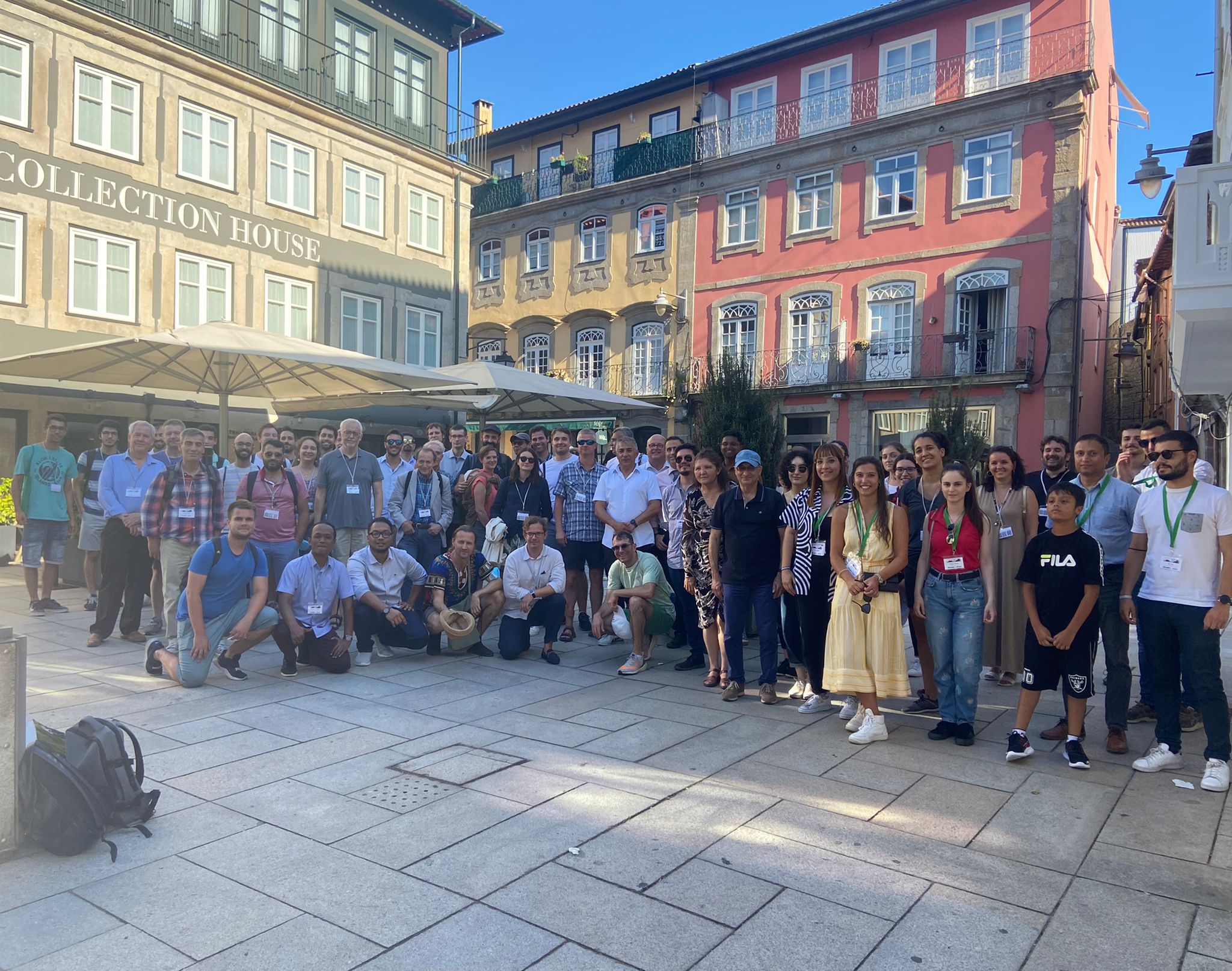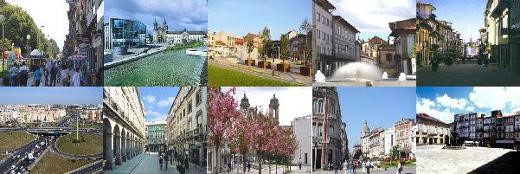Social Program

Monday, July 18
18:20 - 19:30 - Walking tour around Guimarães Historical center (UNESCO World Heritage)
https://www.cm-guimaraes.pt/conhecer/monumentos
https://www.visitguimaraes.travel/descobrir-guimaraes/centro-urbano/centro-historico-patrimonio-mundial/conheca-o-centro-historico-de-guimaraes
The urban rehabilitation policy of the historic center of Guimarães, based on principles of safeguarding the medieval morphology and the recovery and maintenance of traditional building techniques, is recognized nationally and worldwide. For this reason, the Historic Center of Guimarães was declared a World Heritage Site by UNESCO in 2001, taking into account the exceptional value of this architectural ensemble, an authentic testimony of the urban development of the city, containing an enormous diversity of formal and constructive expressions that deserve to be preserved. and valued.
Historic Center Route:
https://www.cm-guimaraes.pt/conhecer/rotas-turisticas/poi-40/igreja-de-nossa-senhora-da-oliveira-24
Nossa Senhora da Oliveira Church
The origins of the Insigne and Royal Collegiate Church of Nossa Senhora da Oliveira date back to the monastery dedicated to the Savior of the World, the Virgin of Santa Maria and the Holy Apostles, founded by Countess Mumadona Dias, around 950. The invocation of Nossa Senhora da Oliveira prevails after 1342, with the greening of an olive tree in the front square. The current building shows successive renovations and additions, integrating elements from different periods - the Gothic reconstruction driven by D. João I; the church tower with Manueline characteristics, completed around 1513-1515; the chancel, of classical architecture, rebuilt in the 19th century. XVII by D. Pedro II; the stuccoes of the main and side chapels are references to the neoclassical renovation begun in 1830; the last intervention dates from the 19th century. XX and intended to expose the granite of the walls and the columns of medieval origin. The church has been classified as a national monument since 1910. It is located nearby S. Tiago square.
https://www.cm-guimaraes.pt/conhecer/rotas-turisticas/poi-40/casa-senhorial-do-seculo-xv
Paço dos Duques de Bragança
Majestic manor house from the 15th century, built by D. Afonso - future Duke of Bragança, bastard son of King D. João I - which served as his residence and his second wife, D. Constança de Noronha.
Palace of vast dimensions, with architectural features of a fortified house, roofs with strong slopes and numerous cylindrical chimneys that denote the influence of the manor architecture of Northern Europe, it is a unique example in the Iberian Peninsula.
The 16th century marks the beginning of progressive abandonment and consequent ruin that worsened until the 20th century. The rebuilding of the palace began in 1937 and lasted until 1959, when it was opened to the public and transformed into a museum whose assets date back to the 17th and 18th centuries.
Of the existing collections, for its valuable contribution to the history of the Portuguese Discoveries, the set of four copies of the Pastrana tapestries, whose design is attributed to the painter Nuno Gonçalves (15th century), which narrate some of the steps of the conquests of the north of Africa, namely Asilah and Tangier. The originals were ordered to be executed in Tournai in the 15th century by the Portuguese king D. Afonso V and are now in Spain. The (unique) copies were acquired by the Portuguese State in 1957 and were carried out in Spain by the Real Fábrica de Tapices in Madrid.
We also find the core of Flemish tapestries, namely those made according to cards by Pieter Paul Rubens, whose themes are episodes from the life of a Roman Consul. These tapestries are notable for their drapery and shadow play. The Museum's collection also includes a display of Portuguese furniture from the post-discoveries period, of which the group of accountants, from the Indo-Portuguese, to the Hispanic-Arabs in the Mudejar style, to the beautiful Spanish Bargeños, deserves special mention.
Decorating the furniture we have a large collection of porcelain from the Companhia das Índias, and Portuguese faience from the main factories of the time: Prado, Viana, Rocha Soares and Rato. In one of the rooms are exposed some of the weapons that were gathered by the second Viscount of Pindela, and later acquired by the Portuguese state, whose collection comprises several examples of bladed weapons, firearms and armor elements from the 15th to the 19th centuries. The building is classified as a National Monument.
https://www.cm-guimaraes.pt/conhecer/rotas-turisticas/poi-40/castelo-24
Castle
The 10th century, Countess Mumadona Dias, after becoming a widow, had a monastery built on her estate in Vimaranes - today Guimarães. The constant attacks by the Moors and Normans led to the need to build a fortress to guard and defend the monks and the Christian community that lived around it. Thus, the primitive Castle of Guimarães appears.
In the 12th century, with the formation of the Condado Portucalense, Count D.Henrique and D.Teresa came to live in Guimarães, who ordered major works to be carried out on the Castle in order to expand it and make it stronger. Tradition says that it was inside the castle that the counts took up residence and that D. Afonso Henriques was probably born there.
Between the 13th and 15th centuries, several kings contributed with works to improve and restore the Castle. Linked to heroic deeds from the period when the nation was founded, such as the Battle of S. Mamede in 1128, which is why it is known as Castelo da Fundação or S. Mamede, it has also served as the stage for several royal conflicts throughout its history.
Having lost its defensive function, the Castle entered a process of abandonment and progressive degradation until the 20th century, when it was declared a National Monument and restoration work was carried out
https://www.cm-guimaraes.pt/conhecer/rotas-turisticas/poi-40/praca-de-s-tiago
S. Tiago Square
According to tradition, an image of the Virgin Mary was brought to Guimarães by the apostle S. Tiago, and placed in a pagan temple in a square that became known as Praça de Santiago.
Quite old square, referred to over time in various documents, still retains its medieval design. It was in its vicinity that the Franks who came to Portugal in the company of Count D. Henrique settled. There was a small porch chapel from the 19th century. XVII dedicated to Santiago that was demolished at the end of the century. XIX.
Tuesday, July 19
18:00 - 19:30 - Walking tour around Couros area (UNESCO World Heritage)
Leather Zone Route:
The tradition of working with leather is already old in Guimarães. We found news that the activity that took place, since the Middle Ages, outside the old walls along the river that crosses the city, in an area once known as the borough of Couros and where today the traces of this ancient connection to the manufacture of furs still persist.
For centuries, the raw materials of this industry have been the hides of cattle slaughtered in the region. Then there are the skins from Brazil and other overseas provinces such as Angola and Mozambique. It was mainly in the 19th century and in the first half of the 20th century that the economic dynamism intensified in the tanneries, being associated with the war conflicts that ravaged Europe.
https://www.cm-guimaraes.pt/conhecer/rotas-turisticas/poi-93/conjunto-de-tanques-no-largo-do-cidade
At the end of Rua de Couros and entering Largo do Cidade, we can see the set of the old tannery factory Mirandas, Ferreira & Carvalho, Lda, which stopped working in the 20th century. This factory resulted from the union of small manufactures that worked here independently. If we look at this structure, we can see that it is quite irregular and different from the others in the area of Couros. This characteristic reveals its antiquity and points out the pre-industrial practices of exploitation of these tanks, which belonged to different owners and were often leased individually to the men of the Couros. The balcony frames the tanks and their relationship with the river. It is worth appreciating the way the water disappears into the labyrinth of structures where the hides were dipped in the lengthy operations for their transformation into leather. In this process, water played a fundamental role, being reused as much as possible between the different phases.
https://www.cm-guimaraes.pt/conhecer/rotas-turisticas/poi-93/fabrica-ancora
The former Âncora factory, currently rehabilitated as a Living Science Center, presents itself as an icon of the constructive typology of Couros, revealing the pre-industrial architectural universe that was inspired by traditional rural architecture, whether in the form of the architectural layout or in the construction techniques, adapting it to new functions.
On the ground floor and around a large patio, there are stores for storing raw materials, for finishing leather work, as well as mills, caterpillars and furs, where the various operations of tanning and beating the skins.
On the upper floor, we find covered, spacious and airy spaces, built in wooden slats, where the skins were dried. This factory also had a dovecote with the aim of guaranteeing access to one of the raw materials needed for the processing of skins: pigeon droppings.
https://www.cm-guimaraes.pt/conhecer/rotas-turisticas/poi-93/fabrica-da-ramada
On Rua da Ramada, the building of the António Martins Ribeiro da Silva factory stands out, founded in the 1930s and known as the Ramada factory.
The building was rehabilitated for academic activities but the traces of its industrial architecture were preserved, namely the colors of the facade, the “yellow straw” and the “ox blood” of the window frames mentioned in the documentation as characteristics of the industrial buildings in the leather area.
The old factory is a symbol of the commitment to technological innovation that this industry witnessed. It appropriated the old alley of Soalhães, as well as the river to expand the production area and be able to install in large spaces the machinery necessary for the required technological improvement, which involved the replacement of traditional vegetable tanning by processes that required knowledge of applied chemistry. This transition to mineral tanning with chromium salts took place in this industrial unit.
The pelts, tanks and mills were closed, creating a uniform floor where the drums or drums were installed, allowing the process of processing the hides to be accelerated, however this chemical process made the activity more polluting.
Despite the technological advances implemented, the environmental awareness of the end of the 20th century forced new requirements in the treatment of effluents, increasing production costs. This factory worked until 2005, always being linked to the Martins Ribeiro da Silva family “os Painços”, having been the last factory that closed its doors in the Couros area.
The Design Institute is currently installed here, the result of a partnership between the Municipality and the University of Minho.
https://www.cm-guimaraes.pt/conhecer/rotas-turisticas/poi-93/largo-do-trovador
The memory of the “first Portuguese troubadour” is associated with this square that develops in a sloping space and where previously there was a Pelourinho. The talent of a son of Rua de Couros, Manuel Gonçalves, was perpetuated in the historical literature of Guimarães, although no traces of his work remain.
In 1880, the City Council of Guimarães assigned this toponymic designation on the occasion of the national commemorations of the tercentenary of Luís de Camões. This square remains in the collective memory with other uses of public space, such as the use of the land to dry the skins in the time when there was a small fountain here.
https://www.cm-guimaraes.pt/conhecer/rotas-turisticas/poi-93/rua-de-couros
It is along Rua de Couros that the heart of the tradition of tanning and beating hides in Guimarães is located. Its arteries extend to the places that surround the river which, in its short and winding path, is unusually known by different names. This is Rio de Couros and it runs in the lower part of this street that connects the City to the small watercourse that crosses it almost invisible. In the Middle Ages, when arts and crafts were perfected, this street already bore its current name. In 1315, the brothers João and Pedro Baião, shoemakers by profession, founded the Brotherhood of S. Crispim and S. Crispiniano and provided the institution with a source of income, bequeathing a pool with seven stone sinks, located on Rua de Couros.
https://www.cm-guimaraes.pt/conhecer/rotas-turisticas/poi-93/rua-de-vila-verde
This street preserves aspects of the way in which the urban organization responded to the needs of the workers. Despite the unhealthy environment, the houses grew up often sharing the walls with the factory buildings and the fields. Here, the water from springs and mines can still be heard, which contributed to the increase in the flow of the river, which in this area was very much in demand. Note the contrast between the buildings that flank the street, on the one hand the colorful housing and the remains of old factories that belonged to the City and that during the 20th century were explored by José Pinheiro Guimarães, known by the nickname of “Roupa Seca". The industrial growth registered in the 19th century and the first half of the 20th century resulted in success for many tanners, thrackers and traders.
The income obtained from work is reflected in the improvement of living conditions. Sober and distinct housing buildings appear, in articulation with the typical working-class neighborhood. Here, the Casa Grande de Vila Verde stands out for its presence, which belonged to Commander Manuel José Teixeira, a wealthy merchant linked to the Leather business. The urban intervention carried out in this area at the end of the 20th century led to a change in the configuration of this street, connecting it to Rua da Ramada and opening it to the surrounding spaces where new buildings emerged.
Wednesday, July 20
14:15 - 19:00 - Visit to the city of Braga

 https://www.youtube.com/watch?v=Jf2bX9fuUR8
https://www.youtube.com/watch?v=Jf2bX9fuUR8
https://www.visitportugal.com/en/destinos/porto-e-norte/73738
https://porto-north-portugal.com/braga-portugal-guide.html
https://feelthecall.pt/minho
https://www.cm-braga.pt/en
https://www.cm-braga.pt/en/0101/conhecer/seja-bem-vindo-a-braga
Braga was founded by the Celts in 300 AC and in 27 AC Bracara Augusta was set as an important roman administrative center. It is the oldest Portuguese town.
A major religious center from the earlier times of Christianity alternated with Santiago de Compostela in Galicia the role of religious capital of the Iberian Peninsula. Illustrating Braga' evolution along the centuries different and diverse architectural styles appear side by side. Nowadays the town holds a charming Baroque splendor.
We are going to spot first at Bom Jesus Hill (UNESCO World Heritage Site) for a 45 minutes visit enjoying the views and the freshness of its gardens. Thereafter the buses we will stop in the center of Braga for a 2.5 to 3 hours free visit to the modern 2000 years old town. Return from Braga at 18:25.
19:30 - 22:30 - Conference Dinner at Hotel de Guimarães Business & Spa
Thursday, July 21
19:00 - … - International Festival Vaudeville Rendez-Vous, at the historical center of Guimarães different contemporary circus performances (kindly offered by Guimarães’ Municipality).
https://teatrodadidascalia.com/en/vaudeville-rendez-vous/
Kinsk • Roi de Rats, Rui Paixão / Holy Clowns, Contemporary Circus, Vaudeville, at the Entrance to the School of Visual Arts - Teatro Jordão, 19:00 (50min performance)
https://www.cm-guimaraes.pt/conhecer/rotas-turisticas/poi-93/conjunto-de-tanques-no-largo-do-cidade
Ensemble • CIA Jupon, Contemporary Circus, Vaudeville, at Largo Condessa do Juncal, 22:00 (50min performance)
https://em.guimaraes.pt/agenda/geo_evento/ensemble-cia-jupon
Friday, July 22
After conference:
International Festival Vaudeville Rendez-Vous, at the historical center of Guimarães different contemporary circus performances, kindly offered by Guimarães’ Municipality.
From iron to rust • Alan Sencades, Contemporary Circus, 19:00 at Largo de Donães.
https://em.guimaraes.pt/agenda/geo_evento/do-ferro-a-ferrugem-alan-sencades
MDR – mort de riure • Los Galindos, Contemporary Circus, 22:00 at Paço dos Duques de Bragança.
https://em.guimaraes.pt/agenda/geo_evento/mdr-mort-de-riure-los-galindos
All week long 2022’ University Futsal World Championship, from 18th to 24th of July, at Multiusos Pavillion











